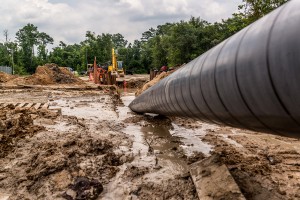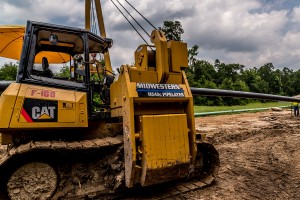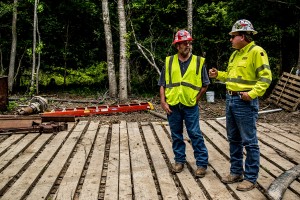January 2014, Vol. 69 No. 1
Features
Another HDD Intersect Record Set

A horizontal directional drilling (HDD) installation completed last summer under the Sabine River and nearby swamplands is believed to be the longest ever made at 11,065 feet.
“We have been unable to find record of a longer HDD project,” said Boyd Simon, P.E., division manager for Digco Utility Construction d/b/a Ranger Field Services, subcontractor responsible for the HDD segment.
The crossing was a segment of a new 12-inch diameter steel natural gas transmission line running 139-miles from Liberty, TX, to Eunice, LA. WHC Inc. was the pipeline contractor; project owner is Crosstex Energy Services.
The installation was made by the intersect method with two HDD units: one on the entry side, the other at the exit end. Intersection was completed on the first attempt.
Simon said pilot holes were drilled with a Mears 1.2 million-pound pullback machine from the entry side and a Vermeer D330x500 with 330,000 pounds of pullback working from the exit end. The entry rig pilot hole was 6,308 feet and the exit side pilot hole was 4,757. True vertical depth of the installation was 92 feet from rig elevation, 71-feet below the river bottom.
“Surface conditions consisted of mostly sandy ground on the exit side and swampy/soft ground on entry side,” Simon continued. “WHC cleared wooded areas and constructed 200-by-200-foot pads at entry and exit locations. Mats were necessary for a board road at the entry location due to the long distance to the nearest roadway.”
Timeframe
Pilot holes and the intersect were completed in 12 days, plus four days for the entry-side rig to push the drill bit to the exit side, Simon said. Pilot holes were drilled with 11 3/4-inch bits and Adtech eight-inch mud motors were used. Twenty-two inch split-bit hole openers made one pass followed by one 18-inch swab pass. Reaming was completed in seven days operating both drill rigs 24 hours a day with two crews on each rig, working 12-hour shifts.

To install casing, complete the intersect and remove the drill bit from the ground required 19 days.
“To make the intersect of the two bores, the larger entry rig drilled as far as possible without losing steering capabilities,” Simon explained. “We had an island to lay out 1,500 feet of coil. Surveying was time consuming and at times difficult due to the heavily-wooded lands and swampy areas. Still, we were able to layout five coils.”
Although there was space to lay out and weld the entire section of pipe for pullback, it could not be laid out straight because of large trees and swampy areas.
“WHC did a fantastic job of keeping all the pipe on rollers as we pulled it back into the hole,” said Simon. “Pullback took 25 hours, including two hours to make pipe repairs.”
Ranger has wide experience completing long bores using the intersect method, but the procedure always is a complex undertaking.
“We were successful because of the knowledge and years of experience of Ranger’s key personnel,” said Simon. “Surveyors, drillers and our superintendents did a fantastic job, always attentive to every detail and committed to safety. There always are many things that can go wrong on these types of crossings, and completing an intersect on the first try as we did on this project is not common at all.”
For their work on the project, Simon cited contributions of superintendents Barry Nailing, James (Tiny) Matlock, Cory Baker, Steve Martin and Colt Benson, along with driller Jody Utz.

“Keys to making the successful intersect,” Simon explained, “were careful planning, including taking the initiative of performing soil sample investigations to determine the best soil layer for the intersect point, and being able to have several check coils throughout the drill path. We maintained very good hole conditions. We had a mud program designed by DCS for this drill and used two of DCS Fluid Solutions’ mud engineers during the entire project.”
Muddy geography
The geography of the location also contributed to difficulties during the course of the project.
“Rig areas on both sides had very soft and muddy conditions,” Simon said. “It was difficult to back trailers and vacuum trucks down the long, narrow board road constructed on the entry side. At the exit point, we had problems pushing out the last 120 feet of drill pipe and bit due to the very soft ground conditions on the surface. A large exit pit had to be dug with sheet pilings in order to finally get our drill bit out of the ground. Although we were near only rural roadways, traffic control was needed due to the quantity of vacuum trucks and pipe trailers that were required.”

A Quanta Services company, Ranger was established in 1993 and specializes in horizontal directional drilling installations beneath waterways, congested areas, highways and environmentally sensitive areas. In addition to directional drilling, Ranger employs a broad range of construction methods. Ranger crews have successfully completed projects in some of the most difficult geological conditions in the United States.
WHC Inc., based in Broussard, LA, specializes in new construction and project management of pipeline systems and facilities, integrity/rehabilitation of existing pipelines and blasting and painting.
Crosstex Energy L.P. is an integrated midstream energy partnership headquartered in Dallas offering diversified, tailored customer solutions spanning the energy value chain with services and infrastructure that link energy production with consumption. Crosstex operates approximately 3,500 miles of natural gas, natural gas liquids and oil pipelines, 10 natural gas processing plants and four fractionators, as well as barge and rail terminals, product storage facilities, brine disposal wells and an extensive truck fleet.
FOR MORE INFO:
Ranger Field Services, (337) 837-5447, www.rangerdirectional.com
Vermeer Corp., (888) 837-6337, www.vermeer.com




Comments